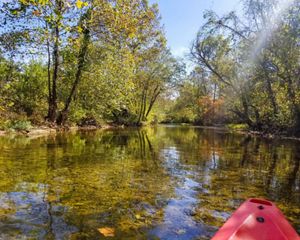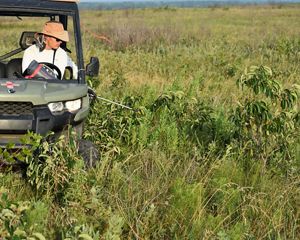Missouri's 4R Nutrient Reduction Program
A program that will help farmers’ bottom line and improve water quality flowing from Missouri all the way to the Gulf.
Increasing crop production and limiting harmful fertilizer and chemical runoff into streams and groundwater is more important than ever as farmers try to meet the needs of a growing population, while maintaining soil and water quality and improving their farm’s sustainability.
In 2018, stakeholders within the state’s agricultural industry, along with The Nature Conservancy and other organizations collaborated to launch a 4R program in Missouri. 4R focuses on nutrient (fertilizer) management and conservation practices to improve soil health and limit the amount of harmful runoff into our rivers and streams. The 4Rs refer to the right fertilizer source, at the right rate, at the right time, and in the right place.
“The agriculture industry is challenged with the task of producing more food than ever before with continuous improvement of soil stewardship. Farmers are the decision-makers when it comes to nutrient management, and the 4R program is designed to empower our farmers through educational resources,” said Andrea Rice, Missouri’s 4R Coordinator.
Learn More About 4R Practices
Check out these educational videos from Show Me Nutrient Stewardship
Watch the VideosThe 4R program provides information and resources for farmers and their advisors as they strive to achieve productive, economic, and environmental goals using an approach focused on sustainability.
“Farmers want to do what is best for maintaining proper soil health and the 4R program has been developed to help them do exactly that,” said Rice. “By focusing on the four ‘rights,’ farmers can identify improvements in fertilizing each specific crop in each specific field and continue to be good stewards for the soil.”
Working with farmers to implement the 4Rs on their land is one of the goals of TNC's sustainable agriculture strategy in Missouri.
What Are the 4Rs?
-

Right Source
Matches fertilizer type to crops needs.
-

Right Rate
Matches amount of fertilizer to crop needs.
-

Right Time
Makes nutrients available when crops need them.
-

Right Place
Keeps nutrients where crops can use them.
Partners in Conservation
When the 4R program was launched in Missouri, it brought together a diverse group of partners – the Missouri Fertilizer Control Board, Missouri Agribusiness Association, Missouri Corn Merchandising Council (MCMC), Missouri Soybean Merchandising Council (MSMC) and The Nature Conservancy.
“Our reasons for collaborating may be different, but our goals are the same,” said Darrick Steen, environmental director for MCMC and MSMC.
4R focuses on nutrient (fertilizer) management and conservation practices to improve soil health and limit the amount of harmful runoff into our rivers and streams.
While we need fertilizers to produce food, a significant amount of fertilizer is washed away by rain, leaving the fields and entering our rivers and streams. This causes issues for fish, recreation and drinking water, which not only affects water quality in Missouri, but eventually travels downriver to the Gulf increasing the hypoxic or dead zone.
“By collaborating with our partners, we will be able to address the needs, benefits and outcomes from the growers, producers and suppliers, while also measuring the impacts to the land,” said Holly Neill, TNC’s director of external affairs.
Quote: Holly Neill
By collaborating with our partners, we will be able to address the needs, benefits and outcomes from the growers, producers and suppliers, while also measuring the impacts to the land.
Steve Taylor, executive director of the Missouri Agribusiness Association and program director of the Missouri Fertilizer Control Board, has been working to bring the 4Rs to Missouri for nearly a decade.
“For years we’ve been talking about the problems and looking for answers. When this came out as a possible solution, we knew that the 4Rs was just good common sense,” said Steve. “It’s good agronomics, but it also shows a process to make sure we get there.”
Steve and Darrick also worked to get the 4Rs included in the Missouri Department of Natural Resources nutrient reduction strategy in 2014, the state’s plan to reduce nutrient run-off.
“This is our industry’s solution – or one of our solutions – to address nutrient run-off,” said Steve.
Bringing TNC into the collaboration not only brought financial support, but also some skin in the game. “They are in the trenches and in the meetings with us to push this forward,” said Steve. “It’s their time and investment that makes this a true partnership.”
Looking to the future, the group is working to get pilot projects on the ground and to continually improve agriculture.
“We want to share with our farmers new technologies and new ways of doing things that ultimately mean a more sustainable investment for them and the next generation that they bring to the farm,” said Darrick. “We want to make sure that our farms are productive and sustainable for our kids and grandkids.”
Sign up for Nature News.
Sign up to receive monthly conservation news and updates from Missouri.



